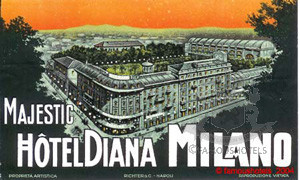The Devil lives at the Diana
( words)
 I boarded the overnight train 235 in Vienna at 7.29pm, and the next morning I found myself driving through the northern plains of Italy, south of the mighty Alps. I had passed through Venice after midnight, Romeo and Juliet's Verona in the morning, soon after the shores of Lake Garda greeted from a distance. At 8.50 I arrived at Milan Central Station, like a traveller a hundred years ago. The hotelier who had called me in this time was Valeriano Antonioli. I knew him from one of his previous posts in St. Petersburg, Russia. He was a clever and innovative man, a born Italian, married to a German. Later that night an English illustrator who lived in Milan would tell me: "Milanese have this wonderful combination of Teutonic discipline with Italian exuberance".
I boarded the overnight train 235 in Vienna at 7.29pm, and the next morning I found myself driving through the northern plains of Italy, south of the mighty Alps. I had passed through Venice after midnight, Romeo and Juliet's Verona in the morning, soon after the shores of Lake Garda greeted from a distance. At 8.50 I arrived at Milan Central Station, like a traveller a hundred years ago. The hotelier who had called me in this time was Valeriano Antonioli. I knew him from one of his previous posts in St. Petersburg, Russia. He was a clever and innovative man, a born Italian, married to a German. Later that night an English illustrator who lived in Milan would tell me: "Milanese have this wonderful combination of Teutonic discipline with Italian exuberance".
Antonioli certainly fitted this description. It was his exuberance that virtually pulled me to the Diana: "Nino Cerrutti is having a permanent suite in my hotel, Gucci's occupying the theatre next door, 1842 there was the first public swimming pool in Italy, the Diana was the first purpose built hotel in Milan, did I tell you that the Prada success story started in our attic, did you know that the hotel was and still is the home of the most famous fashion photographers of the world ... ?"He certainly got me interested. At the Diana I was greeted by Dionisio Gabaldo (left), the chief concierge. He is working there for 30 years, he knew everything and, more important, everybody. Over the next weeks he became my most important link to people connected to the Diana. Do you know Milan? The metropolis of fashion. The capital of publishing and television. The city where Leonardo da Vinci painted the Last Supper and drew sketches of helicopters in his spare time. The place where the Wiener Schnitzel – yes, with noodles – originates. Let me tell you a few more things I have found: Milano (Italian for Milan) is the capital of Milan province and of the Lombardy region (Lombardia). It is the leading financial centre, the most vital and the most prosperous manufacturing and industrious commercial city of Italy. Powerful factors support the argument that Milan should have become the capital of an unified Italy, and this is the belief of many Milanese, in spite of the fact that the unity of Italy in 1870 was actually born in Turin, rather than in Milan. When the Milanese assert that Milan is the moral capital of Italy they not only express the ancient regionalism typical of all Italy and known as Campanilismo (a reference to the church tower of each city) but they also refer to something intangible and yet authentic, for they are speaking of contributions in every field – economic, cultural, and ideological – that the city of Milan, in modern times, and particularly since the unification of Italy, has made to the Italian nation. By the end of the 19th century Milan has become the home to many Swiss and Germans. French writer Stendhal, one of the giants of culture, wished to proclaim himself 'Milanese' when Milan was the most European among Italian cities, but it was not strong enough to become the centre of Europe. It was not by chance that Milan expressed its ideological greatness in the person of a poet, Carlo Porta (1776-1821). Porta wrote in the Milanese dialect and in so doing risked obscurity, both in his own country and abroad; but he simply did it which coincided with the finest aspirations of his fellow citizens over the preceding century. Rome absorbed the values and language of a renascent Florence and integrated them throughout the centuries, as modern Rome demonstrates. In Rome, cinematography, which could never take root in Milan (in spite of numerous attempts) employs the mystery of the physiognomy and of the light of the city to recreate those classic elements, which, in Italy, may be called antique. This Milan could not provide. The majority of its intellectuals, writers, and artists, at least until the end of the post-World War II era, abandoned the city for Rome. Milan thus remained essentially an economic centre, succeeding, however – alone among Italian cities – in keeping alive an inquisitiveness and a spirit of polemic that involved not only these two cities but all the others in Italy as well. The increased importance of the mass media in Italy, particularly of the Milan-based television networks and publishing circles, has favoured the Milanese perspective. Over the past decades, another global factor has been established: fashion. As fashion is reinventing itself every day, Milan has – together with its prosaic appeal – the appearance of a young and sexy city. On the next pages I invite you to accompany me on a short trip through the history of Milan. It will help us to better understand the complex present of this marvellous city, which has such a modern drive and yet so much romance. Like, by the way, the hotel Diana Majestic.






